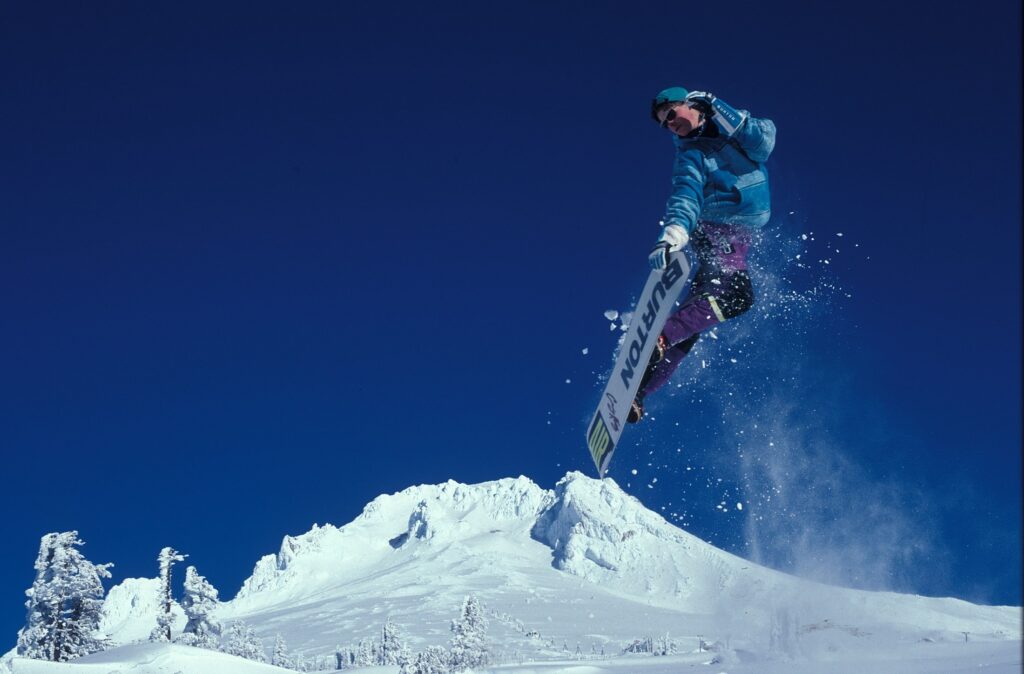Fierce competition, big air, and breathtaking speed—these are what define snowboard cross.
This high-adrenaline event pits four to six snowboarders racing head-to-head down a steep course with jumps, massive berms, and drops. Snowboard cross is exhilarating, fast-paced, and demands exceptional skill and focus from racers. Keep reading & we’ll delve in so you can get a deeper understanding of exactly what snowboard cross is & how snowboard cross works.

Snowboard Cross History
For most of the history of alpine winter sports, this realm was dominated by skiing. The first alpine ski world championship was held in 1931, and skiing was the premier alpine sport for decades.
The first snowboard wasn’t invented until 1965 when an engineer in Michigan attached two skis side-by-side and called it the “snurfer” (a combination of snow, and surfing). Obviously, this was still a long way from modern snowboards, but it was the beginning of the massive snowboard movement that swept over the world.
Over the following decades, people continued to evolve new designs based on the idea of the original snurfer. Innovations included bindings to attach the board to the rider’s boots, experiments with different materials, and various shapes and profiles.
Snowboard competitions were organized and the sport’s popularity spread first through North America and then the rest of the world.
The first snowboard cross event was held at Blackcomb Mountain Resort in British Columbia in 1991. This competition was designed to be an exciting race event for television, and soon more events appeared across Canada, the US, and Australia. The event was originally called boardercross, and many snowboarders outside the Olympics still use this name.
Snowboard cross first appeared in the Winter Olympics in 2006 and has grown in popularity ever since. Interestingly the event is called snowboard cross in the Winter Olympics because the original inventor denied the International Ski Federation the right to use the name boardercross.
Snowboard Cross Course – What is Snowboard Cross?
Snowboard cross races take place on a highly-engineered course that is built and groomed specifically for the competition. These courses involve a variety of features to challenge racers’ technical ability.
- Berms are steep banks set around turns. It is easy to lose control on steep berms, and this is a common place where crashes occur.
- Rollers are rounded humps in the course, usually set with several in a row. Skilled racers can actually use these features to increase their speed.
- Drops are sections where the course sharply drops down a level leaving racers to fly off the edge and land lower down. These require a great deal of strength and focus to land correctly.
- Jumps are exactly what they sound like: features that launch racers high in the air.
The technical features of snowboard cross are part of what makes the event so exciting. There is nothing quite like watching four world-class snowboarders racing at breakneck speeds over jumps & drops.

Snowboard Cross Rules
Because snowboard cross races feature four to six competitors on the course at the same time, there are specific rules to ensure fairness and safety in the competition.
- Snowboarders are not allowed to intentionally grab, pull, or push their competitors or make any physical contact to slow another racer down. Judges are present to determine whether contact between racers is accidental and unavoidable or illegal.
- It is illegal for a snowboard cross racer to maneuver in front of another racer in a way that makes it impossible for them to pass by.
- How does snowboard cross scoring work? The first snowboarder to cross the finish line wins. Video footage is used to determine the winner if it is too close to call visually.
- Most snowboard cross events are structured with multiple elimination rounds until the final round determines the overall winner.
Technique for Snowboard Cross Racers
The berms, rollers, drops and jumps in snowboard cross races challenge a competitor’s technical ability and skill. Courses are typically quite narrow, so with multiple racers at a time, stability and focus are key for avoiding crashes and maximizing speed.
Snowboarders can pump through rollers and other features to increase their speed and carve incredibly tight turns around steep berms. Typically racers keep their center of gravity low to the ground for stability.
Equipment of Snowboard Cross
so how snowboard cross work in the real world, for that, you’ll need an idea of what equipment is used. Snowboards for snowboard cross racers are often longer and narrower than more all-round boards. Snowboard cross boards are also usually
 stiffer and heavier and have a shape profile that is designed for speed and carving turns.
stiffer and heavier and have a shape profile that is designed for speed and carving turns.
Because four competitors are racing side-by-side at high speed and over technical features, crashes are common in snowboard cross. Imagine crashing into another racer at 80 kph (50 mph)! At these speeds, obstacles and sharp snowboards pose the danger of severe injury. Because of this, many snowboard cross competitors wear padded bodysuits for extra protection while racing. Helmets are also required pieces of safety equipment.
Famous Snowboard Cross Athletes
Lindsey Jacobellis
American snowboarder Linsey Jacobellis is almost universally considered the greatest snowboard cross-athlete of all time. She has won ten X Games gold medals, thirty world cups, and six world snowboard championships. After a series of falls and failures in several Olympics, Lindsey finally won the gold medal in the 2022 Winter Olympics.
Seth Wescott
When snowboard cross was introduced to the Winter Olympics in 2006, Seth Wescott was the first-ever Olympic gold medalist. He also won gold at the 2010 Winter Olympics in Vancouver.
Where to Watch Snowboard Cross
Snowboard cross has grown tremendously in popularity since its invention, and it is now featured in many high-profile athletic events. Here are a few of the premier competitions where you can watch the greatest snowboard cross racers.
- Snowboard cross has been featured in the extreme sports X Games since the event’s start in 1997. It is known as Snowboarder X in the winter X Games held every year.
- The FIS Snowboard World Cup is another annual international event where the world’s elite athletes compete in snowboard cross.
- Not to be forgotten, the Winter Olympics have featured snowboard cross since 2006. The Olympic gold medal is arguably the most coveted award for snowboard cross racers.
- There are also dozens of local and regional snowboard cross competitions held around the world. Search for one in your area and go in person!
Top Things to Watch For in Snowboard cross competitions & events
- In the Winter Olympics, four racers face off at the same time and race to reach the finish first (some other snowboard cross events have six racers at a time).
- Snowboard cross courses feature steep berms, rollers, drops, and jumps to challenge racers.
- It is illegal for one racer to grab, push, or impede another. Judges ensure rules are followed and determine what contact is legal.
- Because of the high speed and difficulty, crashes are common in snowboard cross, not for the faint of heart, you can learn more about the dangers of snowboarding here
Snowboard cross-summary
- Snowboard cross is a high-adrenaline race event that involves four to six snowboarders competing head-to-head down a steep course with jumps, berms, and drops.
- Snowboard cross first appeared in the Winter Olympics in 2006 and has grown in popularity since then.
- The course for a snowboard cross race is specifically built and groomed for the competition, with features like berms, rollers, drops, and jumps to challenge the racers’ technical ability.
- Snowboard cross requires exceptional skill and focus from the racers, who must maintain stability and keep their center of gravity low to avoid crashes and maximize speed.
- Snowboard cross boards are usually longer, narrower, and stiffer than more all-around boards, and racers often wear padded bodysuits and helmets for protection.

 About the author
About the author